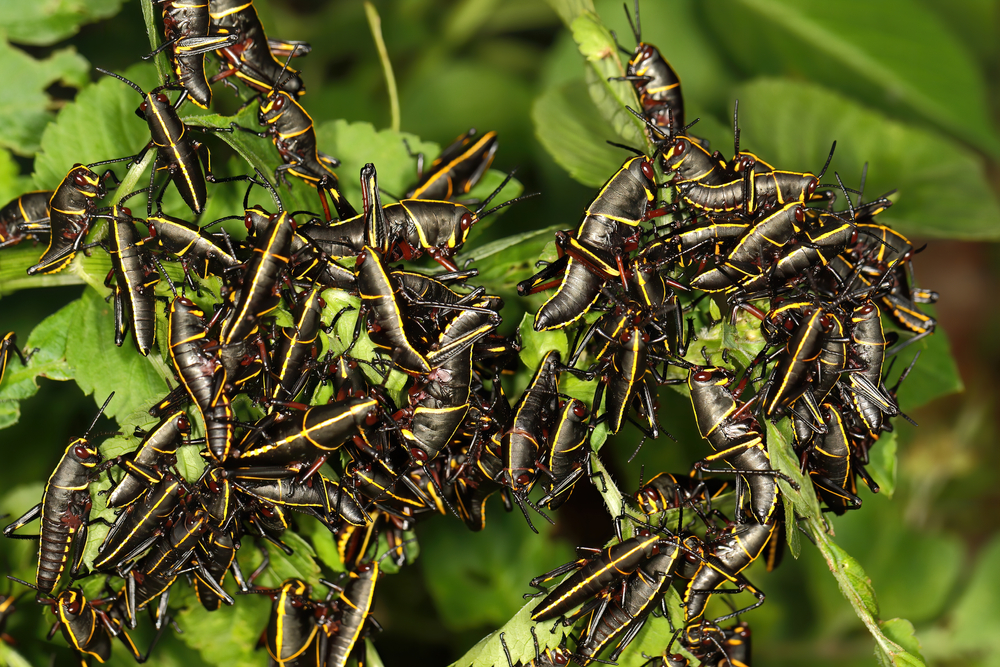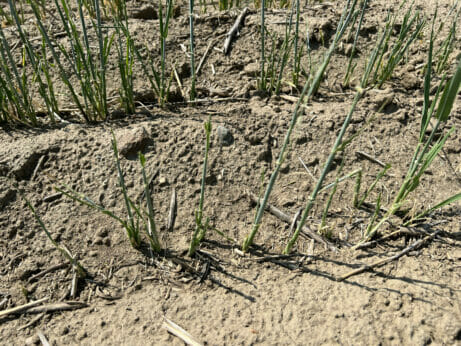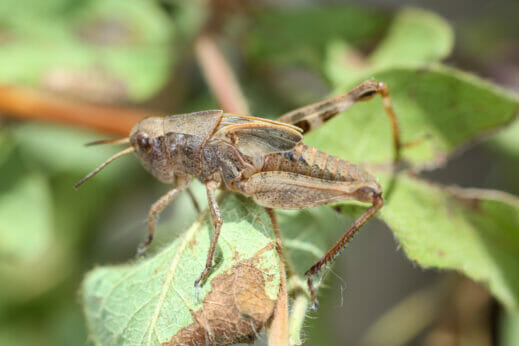Hungry and Seemingly Unstoppable: Grasshoppers Invade Canada’s Prairies
Thriving in the heat and dry conditions of a continuing drought, grasshoppers in southeastern Alberta are eating their way through farmers’ fields. Is there any stopping them?
Hungry and Seemingly Unstoppable: Grasshoppers Invade Canada’s Prairies
Thriving in the heat and dry conditions of a continuing drought, grasshoppers in southeastern Alberta are eating their way through farmers’ fields. Is there any stopping them?

A swarm of grasshoppers devours a plant.by Shutterstock
Every August, the Alberta government surveys grasshopper populations to discern the number of adult females capable of reproduction and egg-laying. Based on these tallies, the following year’s grasshopper population is calculated.
But in 2022, the data was stark: Researchers warned of severe grasshopper infestations in southern Alberta and along the Saskatchewan border. But without much-needed rain, there was very little that could have been done to hold back the hungry hordes.
Dan Johnson is a professor of environmental science at the University of Lethbridge in Alberta. “Grasshoppers are very responsive to weather,” he says.

Females lay their eggs in late summer, sometimes as many as eight pods of between 10 and 90 eggs each. If it’s a wet fall, fungi and bacteria can infect the eggs, limiting their survival rates. If it’s a warm spring, the eggs will hatch early, and the nymphs can develop quickly. In southeastern Alberta, three years of warm springs and long dry summer and fall months have created the perfect conditions for egg laying and population growth.
“The irony,” says Johnson, “is that there are about 80 common species of grasshoppers and only a handful are bad guys. The rest are beneficial to the ecosystem, devouring invasive weeds and providing food for prairie birds like the endangered burrowing owl. In Alberta, it’s the clear-winged and two-striped grasshoppers that are causing all the damage.”
Just 10 of these “bad guys” per square metre can consume between 16 percent and 60 percent of available vegetation. Their meals of choice are: barley, oats, corn, soy, wheat, rye and alfalfa, the mainstay commercial crops of prairie farmers.
Unfortunately, prevention isn’t as easy as spraying the larvae with pesticides. “Spraying has to be targeted, and unless you know the difference between the larva of the bad versus good grasshopper, which many people don’t, spraying can be ineffective,” says Johnson. Then, once the insects start eating, it’s too late to fight back. “Insecticides can deter some of them, but when the numbers are as high as they are now, it’s pretty much impossible to eradicate them all.”
Even if a farmer does spray, there’s often a wait time between the application of a chemical pesticide and when it’s safe to harvest a crop. This means farms have to keep the crop alive and use up precious water resources in an already water-restricted environment.

Stewart Wells is a third-generation farmer and owner of Penny Lane Organic Farms in Swift Current, SK. The farm’s organic certification means he is unable to use synthetic pesticides, so he instead relies on natural controls for his wheat, lentils, peas, alfalfa, mustard and coriander. While most of what he’s growing are traditional cash crops, the coriander isn’t for commercial sale. It’s for the grasshoppers. “They don’t like the smell and will avoid areas where it’s planted,” he says. Does it work? “Moderately.” Unfortunately, there aren’t many other proven methods to use. Wells could try to seed his crops early, so they can be harvested before the nymphs mature into eating machines. But that’s tricky. Farmers need warm weather to seed, and the warmer it gets, the faster the nymphs grow.
It all adds up to a smorgasbord for the hungry insects.
Justine Comeau is an agricultural fieldman for southeastern Alberta’s Special Areas Board. An agency of the Government of Alberta, the board acts as a rural municipal service and, during a crisis, provides support to residents of the region. “Many of us remember the drought of the early 2000s and how grasshoppers ate the siding off houses. They were everywhere—even roads and highways had to be closed. This year is almost as bad,” she says.
Across North America, farmers and ranchers are telling similar stories. In 2022, Oregon had an estimated 5.3 million acres of farm and ranchland infested by destructive grasshoppers. In some places, the average density was estimated at 73 grasshoppers per square yard. The United States Department of Agriculture sets a threshold of 15 to 20 nymphs or 8 to 10 adults per square yard before economic damage occurs.
“The financial impact of Alberta’s 2023 grasshopper infestation will vary from zero to 100 percent loss, depending on the area,” says Comeau. “There are pockets where there are none and, in other areas, 100 per square metre.
“For many livestock producers, the few grazing areas left that haven’t dried up because of lack of water have now been eaten by the grasshoppers,” says Comeau. The situation has become so serious that ranchers are having to destock herds.” It will take years for the pastures and perennial forages to recover, and that’s only if conditions improve. In the meantime, the costs and damages keep adding up. The effects of the 2001-2002 drought and all its combined losses, including grasshopper damage, cost the Canadian economy $5.8 billion.

The effects of this drought could be even more far-reaching. Alberta exports seven million tons of wheat each year to 70 countries around the world. With supplies of wheat already hampered by the Russian invasion of Ukraine, a blow like this could put another dent in an already dwindling supply.
In July, the Special Areas Board declared an agricultural disaster in southeastern Alberta, in hopes of making it easier for producers to get financial help from the province and access crop insurance claims. It will help, but it won’t solve the overall problem. If the hoped-for rains come and the drought abates, it won’t be the last time farmers and ranchers will have to deal with apocalyptic hordes of grasshoppers. According to the Government of Alberta’s climate change website, elongated periods of hot and dry weather are predicted to become more frequent in the province and to last longer because of climate change.
Along with the heat and arid conditions, there will be grasshoppers.
Follow us
This work is licensed under a Creative Commons Attribution-NoDerivatives 4.0 International License.
Want to republish a Modern Farmer story?
We are happy for Modern Farmer stories to be shared, and encourage you to republish our articles for your audience. When doing so, we ask that you follow these guidelines:
Please credit us and our writers
For the author byline, please use “Author Name, Modern Farmer.” At the top of our stories, if on the web, please include this text and link: “This story was originally published by Modern Farmer.”
Please make sure to include a link back to either our home page or the article URL.
At the bottom of the story, please include the following text:
“Modern Farmer is a nonprofit initiative dedicated to raising awareness and catalyzing action at the intersection of food, agriculture, and society. Read more at <link>Modern Farmer</link>.”
Use our widget
We’d like to be able to track our stories, so we ask that if you republish our content, you do so using our widget (located on the left hand side of the article). The HTML code has a built-in tracker that tells us the data and domain where the story was published, as well as view counts.
Check the image requirements
It’s your responsibility to confirm you're licensed to republish images in our articles. Some images, such as those from commercial providers, don't allow their images to be republished without permission or payment. Copyright terms are generally listed in the image caption and attribution. You are welcome to omit our images or substitute with your own. Charts and interactive graphics follow the same rules.
Don’t change too much. Or, ask us first.
Articles must be republished in their entirety. It’s okay to change references to time (“today” to “yesterday”) or location (“Iowa City, IA” to “here”). But please keep everything else the same.
If you feel strongly that a more material edit needs to be made, get in touch with us at [email protected]. We’re happy to discuss it with the original author, but we must have prior approval for changes before publication.
Special cases
Extracts. You may run the first few lines or paragraphs of the article and then say: “Read the full article at Modern Farmer” with a link back to the original article.
Quotes. You may quote authors provided you include a link back to the article URL.
Translations. These require writer approval. To inquire about translation of a Modern Farmer article, contact us at [email protected]
Signed consent / copyright release forms. These are not required, provided you are following these guidelines.
Print. Articles can be republished in print under these same rules, with the exception that you do not need to include the links.
Tag us
When sharing the story on social media, please tag us using the following: - Twitter (@ModFarm) - Facebook (@ModernFarmerMedia) - Instagram (@modfarm)
Use our content respectfully
Modern Farmer is a nonprofit and as such we share our content for free and in good faith in order to reach new audiences. Respectfully,
No selling ads against our stories. It’s okay to put our stories on pages with ads.
Don’t republish our material wholesale, or automatically; you need to select stories to be republished individually.
You have no rights to sell, license, syndicate, or otherwise represent yourself as the authorized owner of our material to any third parties. This means that you cannot actively publish or submit our work for syndication to third party platforms or apps like Apple News or Google News. We understand that publishers cannot fully control when certain third parties automatically summarize or crawl content from publishers’ own sites.
Keep in touch
We want to hear from you if you love Modern Farmer content, have a collaboration idea, or anything else to share. As a nonprofit outlet, we work in service of our community and are always open to comments, feedback, and ideas. Contact us at [email protected].by Jennifer Cole, Modern Farmer
August 25, 2023
Modern Farmer Weekly
Solutions Hub
Innovations, ideas and inspiration. Actionable solutions for a resilient food system.
ExploreExplore other topics
Share With Us
We want to hear from Modern Farmer readers who have thoughtful commentary, actionable solutions, or helpful ideas to share.
SubmitNecessary cookies are absolutely essential for the website to function properly. This category only includes cookies that ensures basic functionalities and security features of the website. These cookies do not store any personal information.
Any cookies that may not be particularly necessary for the website to function and are used specifically to collect user personal data via analytics, ads, other embedded contents are termed as non-necessary cookies.
Do grasshoppers have a mating call which might be deployed to capture them en mass? What potential markets are there for mass quantities of captured grasshoppers?
During a peak in grasshopper populations in Montana a wise old rancher sold cows he was willing to cull and used the money to buy hundreds of turkeys. He modified livestock trailers to house the turkeys at night. Hired a few people to watch the turkeys during the day. When November rolled around he made a profit and was able to buy well bred heifers the next spring. He even said that he was somewhat sorry to see all those grasshoppers go.
Mobile turkey houses, ala Joe Salatin are worth a look. They would have to be taller, bigger and pulled by a tractor (maybe) but they just might work. Google how to get in touch with Joe Salatin or go to his YouTube channel. Or already tried and true chicken houses with chickens if they will eat the grasshoppers and they are moveable by two people without a tractor. Hope this can help.
What all have people been doing to increase the threat of these impacts? What can non farmers do to help out the issue?